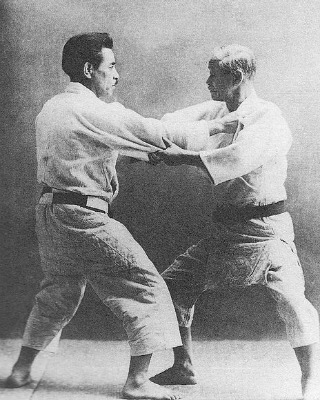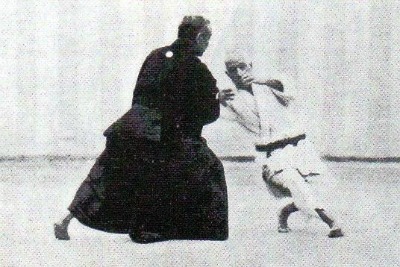The History of Judo
What is Judo?
Judo is a system of fighting that was created in 1882 by Jigoro Kano. It was derived from jiu-jitsu, the hand-to-hand combat techniques used by the
samurai and consists mostly of throwing, pinning, joint locks and choke holds.
Leverage, speed and technique are used to utilise an opponent’s own energy against him while
the judo code of conduct encourages respect for others and the ethical and moral growth of all judoka.
While today judo is predominantly practised as a combat sport in Japan
and all over the world, the art still contains deadly martial arts moves, mostly preserved in its kata.
Talk the Talk
Jigoro Kano’s new martial arts school was called Kodokan judo, which is a composite of three words:
Ko – Meaning study
Do – Meaning the path or way
Kan – Meaning place or hall
Therefore, Kodokan translates to A Place to Study the Way. Likewise, judo is a composite of two words:
Ju – Meaning gentle
Do – Meaning the path or way
Therefore, judo can be translated into the Gentle Way. When putting these together, Kodokan judo can be said to
translate to A Place to Study the Gentle Way.

Judo’s origins can be said to date back to the sixteenth century when jiu-jitsu schools that were dedicated to teaching the hand-to-hand combat techniques of the samurai began to spring up in Japan along with other martial arts forms such as kenjutsu (the forebearer of modern kendo).
By the mid-nineteenth century, there were over seven-hundred martial arts schools in the country however, in 1868 everything changed with the Meiji Restoration whereby Imperial rule was restored. The samurai class and most of their cultural traits went into decline, including a rapid reduction of jiu-jitsu clubs and practitioners.
Jigoro Kano – The Founder of Judo
Jigoro Kano was a highly educated person who was so influential on the subject of teaching that he is considered today to be the founder of the modern Japanese educational system, especially in reference to physical/sports education. He was also an expert in two traditional jiu-jitsu systems, Tenshin Shin'yo Ryu and the Kito Ryu, and he had some experience studying several other traditional styles and forms of fighting.
Kano realised that in light of the changes his country was going through, the martial arts would need to adapt to survive. To aid this, in 1882 at the age of just 22, he combined what he had learned from traditional jiu-jitsu and founded his own style that would become known as Kodokan Judo.
The Development of Kodokan Judo
By removing the more dangerous techniques and concentrating on throws and grappling moves, Kano devised the Japanese combat sport so that it would develop its practitioners both mentally and physically while preserving many of the martial arts moves jiu-jitsu had to offer. He would also continue to teach kata, prearranged forms consisting of attacking and defensive movements which contained the deadlier techniques from within the art and in doing so further helped preserve the skills of traditional jiu-jitsu.
Much of the jiu-jitsu training in Kano’s day was based around kata and while he believed this was important, he also felt that there was too much emphasis on it and his students needed to practice their skills more realistically. As a result, he innovated randori, the practice of non-cooperative free sparring.
In 1886, the Tokyo Police hosted a tournament providing the Kodokan judoka with a chance to show how their new style compared with established jiu-jitsu styles. In total, fifteen fights put Kano’s students up against more traditional fighters, with the Kodokan coming out on top in thirteen of the bouts with the remaining two contests being draws.
In 1889, Kano visited Europe to help spread his new art. While on a boat en route, he encountered a man who thought it would be humorous to make fun of the master. A fight ensued and Kano threw the man to the ground but what impressed onlookers the most was the way he placed his hand behind the man’s head to prevent him from getting hurt on impact with the ground. This highlights the importance within judo of combining self-defence with respecting human life, even when that person is a would-be attacker and demonstrates that right from judo’s origins, it was designed to be the gentle way.
Jigoro Kano would travel abroad to teach judo a further seven times as well as other times to attend the Olympics and its committee meetings, of which he was a member. He also sent several of his best students, such as Mitsuyo Maeda, overseas to demonstrate and teach judo in order to help his new art grow.
Over the coming years, the Kodokan saw much success in competition until around the turn of the twentieth century when they came up against the students of Mataemon Tanabe, a teacher of an obscure jiu-jitsu style known as the Fusen Ryu. This was a turning point in judo history as up until this time, Kano mostly taught throws that would be executed from a standing position. However, the Fusen Ryu were experts in takedowns and ground work which they used to beat all of the judoka by submission. Kano was understandably impressed by this and invited Tanabe to teach groundwork at the Kodokan judo school, after which it was incorporated into the style.
As a result of his educational connections, he managed to get judo accepted onto the syllabus in Japanese schools in 1911, having it taught as not just a form of self-defence, but also a combat sport and a way to build character in its participants. By the 1920s, Kano was the most influential martial artist in Japan and was always willing to help new art forms such as karate and aikido get a following in the country. After seeing a demonstration of aikido by its founder Morihei Ueshiba, Kano was so impressed that he sent some of his own students to train with him and he was instrumental in getting karate accepted in the country when it was brought to Japan from Okinawa by Gichin Funakoshi in the 1920s.
Further Developments in Judo History
Another key development in judo history happened in 1964 when it became an Olympic event in Tokyo, though at this stage it was only men competing in various weight categories. Women’s judo appeared in the 1988 Seoul Olympics as a demonstration event and was then added as an event in its own right four years later in Barcelona.
When he first established his school, Jigoro Kano had just nine students and practised in a very small dojo with only enough room for twelve mats. However, the popularity of judo soon soared, especially after its acceptance into the Olympics and his dojo went from strength to strength; today the Kodokan has more than five hundred mats and gets in excess of a million visitors per year. Judo is now one of the most popular combat sports in Japan and is also practised all over the world with over one hundred and eighty countries and regions holding membership with the world governing body of the sport, the International Judo Federation.
Written by Andrew Griffiths – Last updated 23/06/2023. If you like
what you see, consider following the History of Fighting on social media.
Further Reading:
Dakin Burdick. [Internet]. 2018. Judo. Britannica. Available from: https://www.britannica.com/sports/judo [Accessed July 24, 2018].
History of Brazilian Jiu Jitsu. [Internet]. 2018. Shen Wu. Available from: http://www.shenwu.com/bjjhistory.html [Accessed July 24, 2018].
History of Judo. [Internet]. 2018. California State University. Available from: https://www.csub.edu/judo/history.html [Accessed July 24, 2018].
History of Kodokan Judo. [Internet]. 2018. Kodokan Judo Institute. Available from: http://kodokanjudoinstitute.org/en/doctrine/history [Accessed July 24, 2018].
Judo Club. [Internet]. 2018. The University of Hawaii. Available from: https://hilo.hawaii.edu/rec/Judo.php [Accessed July 24, 2018].
Judo History. [Internet]. 2018. Judo Info. Available from: http://judoinfo.com/jhist4 [Accessed July 24, 2018].
The History of Judo. [Internet]. 2018. Web Japan. Available from: http://web-japan.org/kidsweb/virtual/judo/judo01.html [Accessed July 24, 2018].
The images on this site are believed to be in the public domain, however, if any mistakes have been made and your copyright or intellectual rights have been breeched, please contact andrew@articlesonhistory.com.

